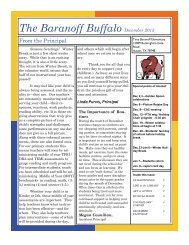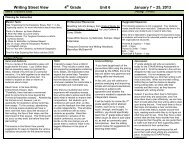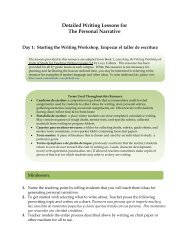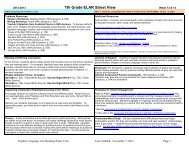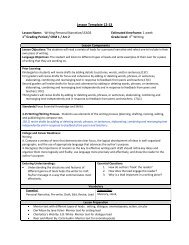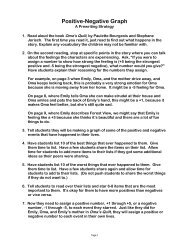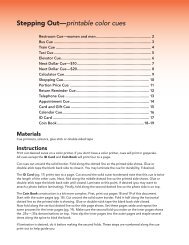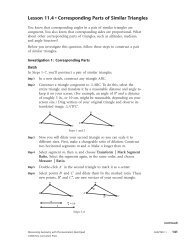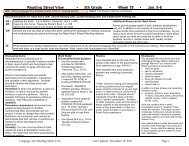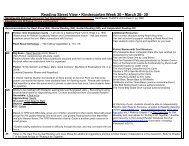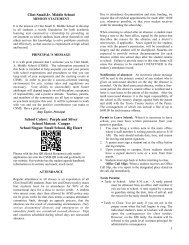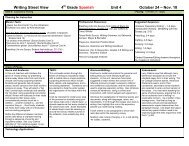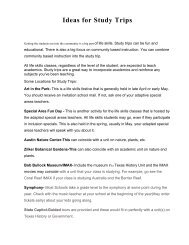Course: 8th Grade Model Lesson for Middle School ELAR Grading ...
Course: 8th Grade Model Lesson for Middle School ELAR Grading ...
Course: 8th Grade Model Lesson for Middle School ELAR Grading ...
- No tags were found...
You also want an ePaper? Increase the reach of your titles
YUMPU automatically turns print PDFs into web optimized ePapers that Google loves.
<strong>Course</strong>: 8 th <strong>Grade</strong><strong>Grading</strong> Period: 3 rd Six WeeksTEKS: 8.11A, 8.11B, 8.18B<strong>Model</strong> <strong>Lesson</strong> <strong>for</strong> <strong>Middle</strong> <strong>School</strong> <strong>ELAR</strong>Unit: Perspectives-Persuasion and In<strong>for</strong>mation in Reading and WritingArc: Persuasion in Writing 2010-2011<strong>Lesson</strong> Title: Original Political CartoonELPS: 2C, 3C, 3E, 5B, 5GCCRS: Writing A1, A2<strong>Lesson</strong> Components: <strong>Lesson</strong>, Political Cartoon ExamplesPacing: 2 DaysVocabulary: issue, claimResources: “Can Cartoons Have a Point?” pp. 852-855 Holt McDougal Literature <strong>Grade</strong> 8Political cartoons from newspapers, magazines, social studies textbooksBlank paper, colored pens or pencilsInstructional StepsTeachers Do:Students Do:Day 1:Day 2:1. Give “Quick Write” task-Project a political cartoon where all studentscan see it clearly. Students will describe the cartoon, name theintended audience, name the type of persuasive appeal used in thecartoon (pathos, logos, ethos), and determine if the cartoon ispersuasively successful and include evidence.2. Allow students to share their cartoon analysis in small group or wholegroup.3. Define the words: issue, claim• Issue-a point of discussion, debate, or dispute• Claim-a statement of something as a fact; an assertion of truthAsk students what they think the “issue” is in the cartoon. Then askthem to identify the “claim.” Allow students to talk about their ideasconcerning “issue” and “claim.”4. Give students other political cartoons, or allow students to findexamples of political cartoons as homework. Ask student pairs to selectone cartoon to analyze. They will go through the same process ofanalysis (Quick Write): describe what they see, name the intendedaudience, name the type of persuasive appeal, evaluate <strong>for</strong> success inpersuasion, including evidence. Ask student partners to share theiranalysis with the class and explain their thinking.5. Review the terms “issue” and “claim.”Day 1:Day 2:1. Look at a political cartoon, describe what is shown, name the intendedaudience, name the persuasive appeal, and evaluate the cartoon <strong>for</strong> itssuccess in persuasion.2. Share cartoon analysis in a small group or the whole class.3. Listen to the teacher’s definition of “issue” and “claim.” Ask <strong>for</strong>clarification, if needed. Participate in determining the issue and claimmade in the projected cartoon.4. With a partner, select a new political cartoon provided by the teacher orbring political cartoon examples from home. With a partner, describewhat is pictured in the cartoon, name an intended audience, name thetype of persuasive appeal, and evaluate the cartoon <strong>for</strong> its persuasivesuccess. Partners can share analysis and thinking behind analysis tothe whole class.5. Review with the teacher the terms “issue” and “claim.”6. Listen as the teacher makes the political cartoon assignment. Askquestions about the assignment, the graphic organizer, or the rubric ifthere is confusion.7. Using the tools provided, create a political cartoon about a currentsocial issue or a school issue.
6. Give each student a Political Cartoon Graphic Organizer, a PoliticalCartoon Rubric, and access to blank paper and colored pens andpencils.8. After turning in the political cartoon and graphic organizer to theteacher, participate in a class gallery walk. Leave positive commentson post-it notes <strong>for</strong> other students’ political cartoons.7. Each student will create a political cartoon of a current social issue orschool issue. For their cartoon, each student will determine the issueand claim, an intended audience, the type of persuasive appeal used,the visual and caption. The graphic organizer and rubric will helpstudents plan and evaluate their work.8. Display students political cartoons and provide time <strong>for</strong> a class “gallerywalk.” Give all students post-it notes so they can leave positivecomments on the cartoons they see in the “gallery walk.”Differentiated Instruction:• If appropriate, students may be allowed to create a visual cartoon without a caption.• Teacher guides students throughout the processObservation: Student questions, group participation, work processFormative Assessment:Student Work Products/Rubric: Original Political CartoonSummative Assessment/Rubric:Other:Evidence of Learning© 2010 Austin Independent <strong>School</strong> District 7/21/10
Political Cartoon Graphic OrganizerCurrent social orschool issueClaim presentedIntended audiencePersuasiveappeal usedVisual descriptionCaption statement
Political Cartoon RubricIssueClaimStrong Satisfactory Needs WorkCartoon reflects a Cartoon reflectscontroversial issue in today’s society ortoday’s society or schoolsschoolsCartoon reflects thecomplexities of acontroversial issue intoday’s society orschoolsCartoon clearly statesan opinion about theissueCartoon states anopinion about theissueCartoon does notpresent a clear opinionPersuasive AppealPersuasive appeal isused successfullyPersuasive appeal isusedPersuasive appeal isnot evidentVisual DesignDrawing is clearlylegibleDrawing is mostlylegibleDrawing is barelylegibleCaptionCaption is related todesign and provides aclear verbal cue aboutmeaning and issueCaption is related tothe design and issue.Caption connection todesign and issue isunclear.



